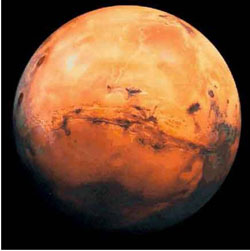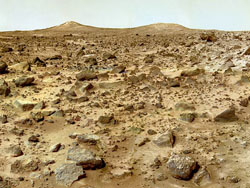Lecture About Mars Set in Blasdell
By Frank Parlato
There won't be a field trip, but the first of the 2014 Penn Dixie's Winter/ Spring Lecture series will almost take you there.
"Unraveling the Geologic History of Mars," is the topic and Kevin Williams, associate professor of Earth Sciences at Buffalo State will make the presentation Wednesday, Jan. 22, at 7 p.m. in the auditorium of the Gateway Executive Office, at 3556 Lake Shore Road, Blasdell.
The public is welcome. Cost is $4/person. Penn Dixie Members are admitted for free.
This will be an informative program for families, students, scouts, and anyone interested in learning about Mars, a planet named after the Roman god of war and described as the "Red Planet." Iron oxide on its surface gives it its reddish appearance.
There is much to learn about Mars, which has a thin atmosphere, craters, volcanoes, lava, valleys, deserts, and polar ice caps and the Olympus Mons, at 14 miles, the second highest known mountain in the Solar System, and three times as high as Mt. Everest, and Valles Marineris, a canyon 2,500 miles long and up to 4 miles deep, some five times as large as the Grand Canyon.
Mars has two moons, and once had water on its surface during a warmer, wetter period. The two polar ice caps appear to be made of water, enough to cover the entire planet with perhaps 30 feet of water were they to melt.
Chlorine, phosphorus and sulfur are more common on Mars than Earth. Mars also appears to have been struck by a large meteor about four billion years ago creating a smooth Borealis basin that covers 40 per cent of the planet.
For those thinking of possibly relocating there, the atmosphere of Mars is thin, and not very conducive to humans. It consists of about 96 percent carbon dioxide, 1.93 percent argon and 1.89 percent nitrogen along with traces of oxygen and water. On top of that, the atmosphere is quite dusty which gives the Martian sky a tawny color when seen from the surface.
One however can enjoy the four seasons and at about twice the length of Earth, as the Martian year is about two Earth years long. Some might find it a little cold, however. The average temperature on Mars is about -81 ºF. With lows of about -225º F (at the winter polar caps) and highs of up to 95º F (in equatorial summer). The planet is 1.52 times farther from the Sun than Earth resulting in it getting just 43 percent of the amount of sunlight Earthlings enjoy.
A day on Mars is only slightly longer than an Earth day: 24 hours, 39 minutes, and 35 seconds.
So far various unmanned spacecraft have not detected life on Mars' surface, although for much of Earth's modern history, it was suspected there was. As astronomer Carl Sagan wrote, "Mars has become a kind of mythic arena onto which we have projected our Earthly hopes and fears."
Meantime, for those seriously considering living on Mars, a mission to put humans on Mars drew 200,000 applicants. It will be whittled down to 24 would-be Mars-dwellers.
"Mars One" was set up in 2011 by two Dutch men with the goal of establishing permanent human life on Mars in 2025. They presently lack the money, but hope the project will be funded by investors and the rights from the documentary-reality TV broadcasting of the tests, training and final selection. So far 1,058 candidates got through to the first round. By far the largest number - 297 - are American, followed by 75 Canadians and 62 Indians. They must now undergo rigorous tests, including simulations of life on Mars and coping with isolation, co-founder Bas Lansdorp said.
But before you apply, we recommend going to Prof Williams' lecture.


